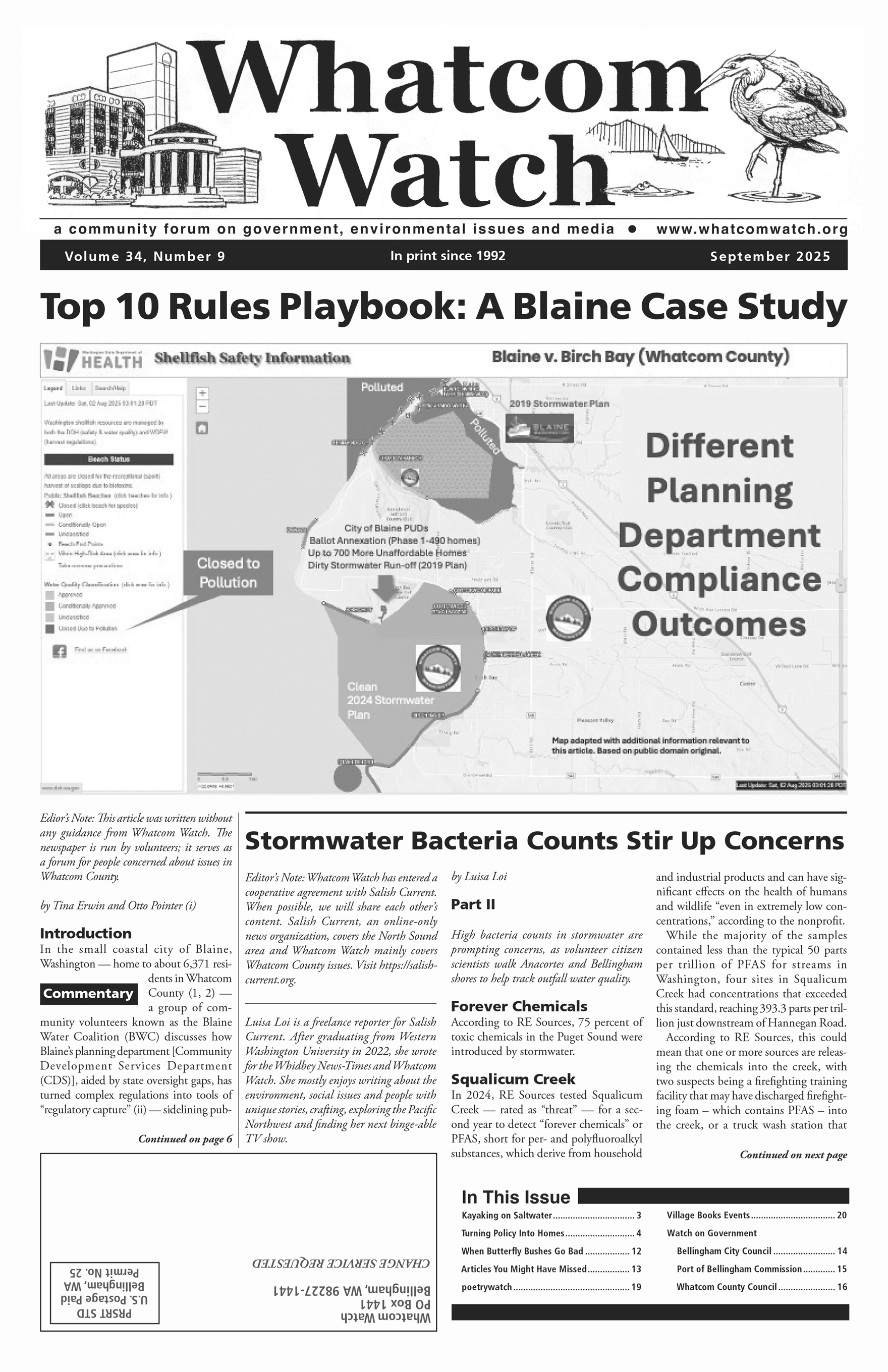Editor’s Note: This article was written without any guidance from Whatcom Watch. The newspaper is run by volunteers; it serves as a forum for people concerned about issues in Whatcom County.
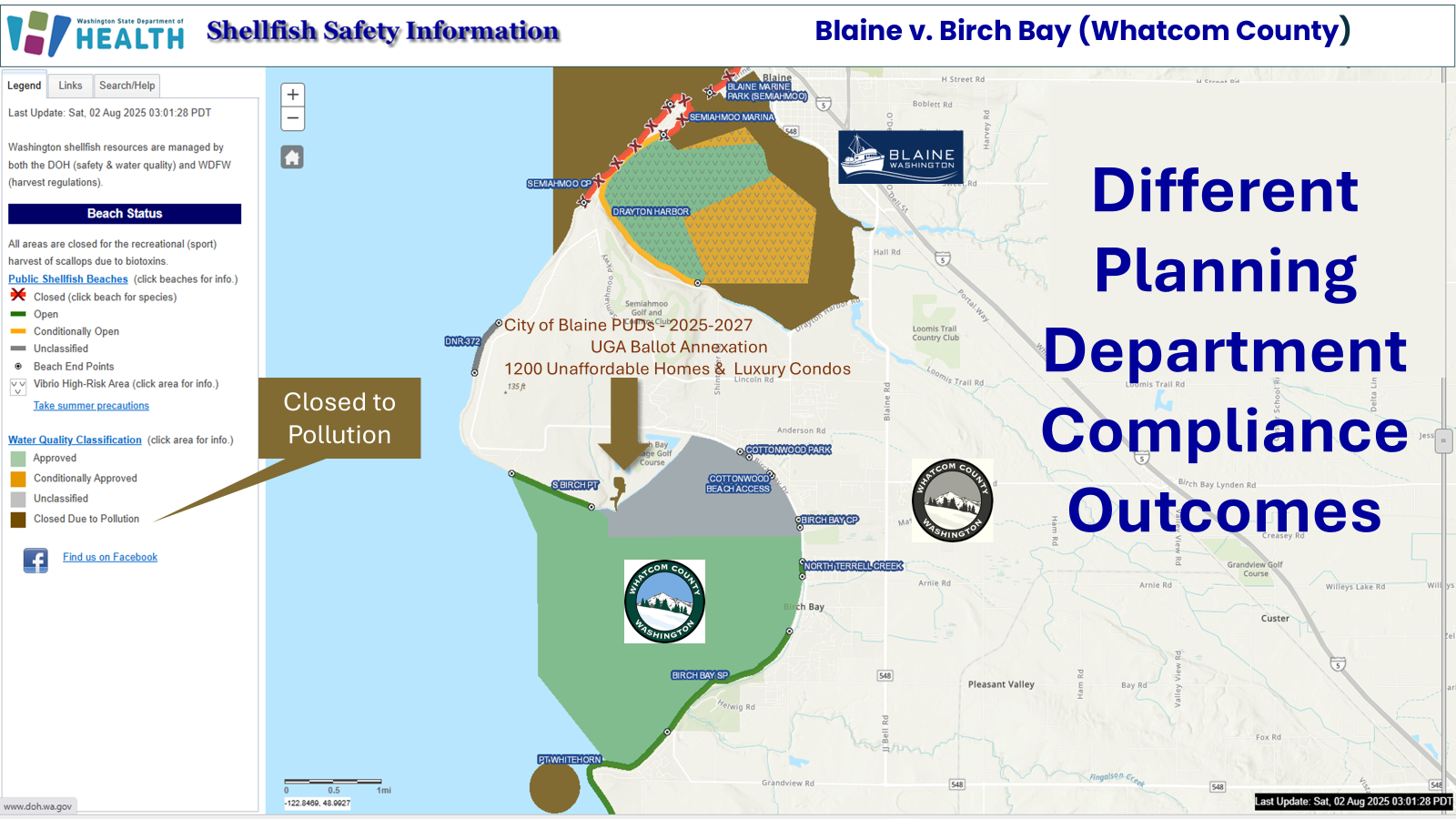
by Tina Erwin and Otto Pointer (i)
Introduction
In the small coastal city of Blaine, Washington — home to about 6,371 residents in Whatcom County (1, 2) — a group of community volunteers known as the Blaine Water Coalition (BWC) discusses how Blaine’s planning department [Community Development Services Department (CDS)], aided by state oversight gaps, has turned complex regulations into tools of “regulatory capture” (ii) — sidelining public input, skirting environmental protections and raising alarms for the health of Blaine, Birch Bay, and surrounding communities.
Volunteers have spent the past three years (2022–2025) investigating local planning decisions that they believe risk environmental harm, particularly to vital water resources like aquifers and shellfish habitats that support safe drinking water, tourism and the local economy. Led by retired Navy Commander Tina Erwin and spokesperson Otto Pointer, this nonpartisan effort draws from over 4,000 hours of analysis, hearings, and agency interactions. This article outlines a “playbook” of tactics observed in Blaine’s planning department, while highlighting broader trends across Whatcom County and potentially the state, with goals of empowering residents to engage more effectively in shaping land-use decisions for sustainable growth. BWC advocates for water quality protections, compliance and responsible development.
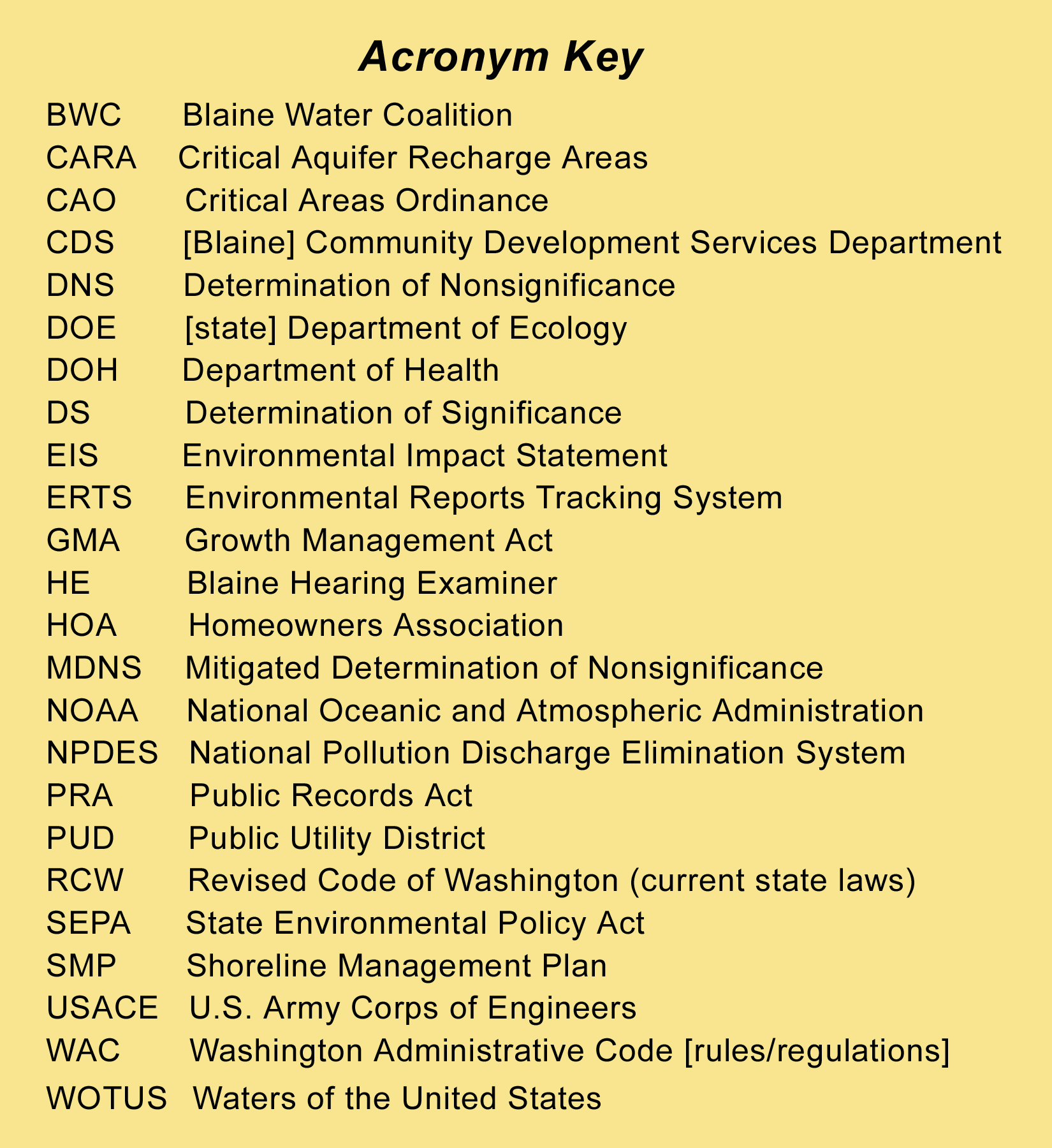
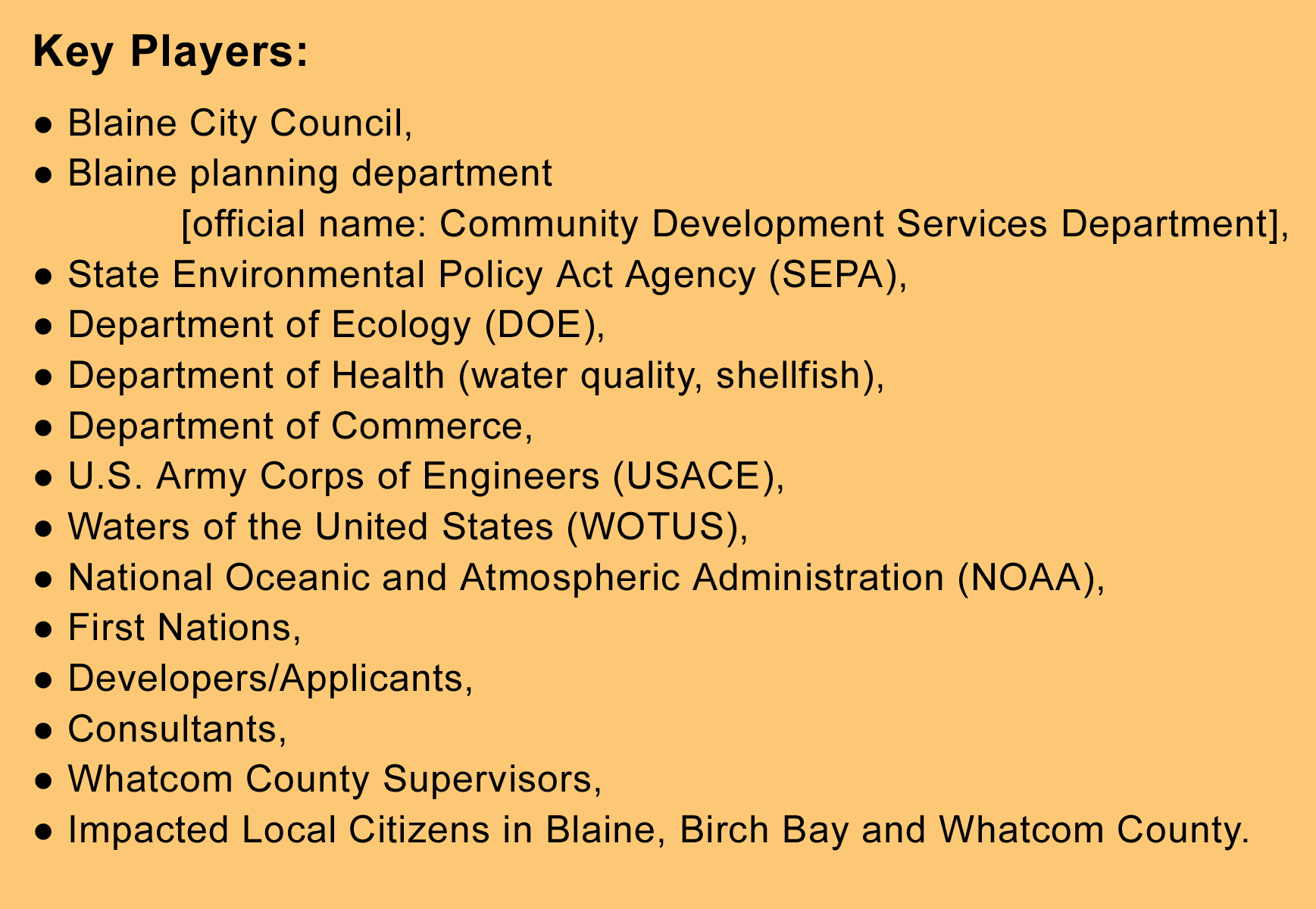
Origins of the 10 Rules
Our “Blaine Planning Department’s Top 10 Rules” originate from local and county experiences, not extrapolation. We have spent considerable time cutting through the arcane web of overlapping local municipal and state codes used by planning departments such as the City of Blaine’s to obstruct citizen engagement. Gaps in state oversight have enabled Blaine to excel at regulatory capture, avoid duty of care and state ethics standards.
Operating under the appearance of fairness, citizen’ civil rights have been violated, the City of Blaine has sidestepped Department of Ecology (DOE) rules, and, more recently, engaged in alleged misconduct. Our hundreds of hours of research have uncovered a pattern of practices that we believe cross legal and ethical lines, leading to environmental harm to our water and public health.
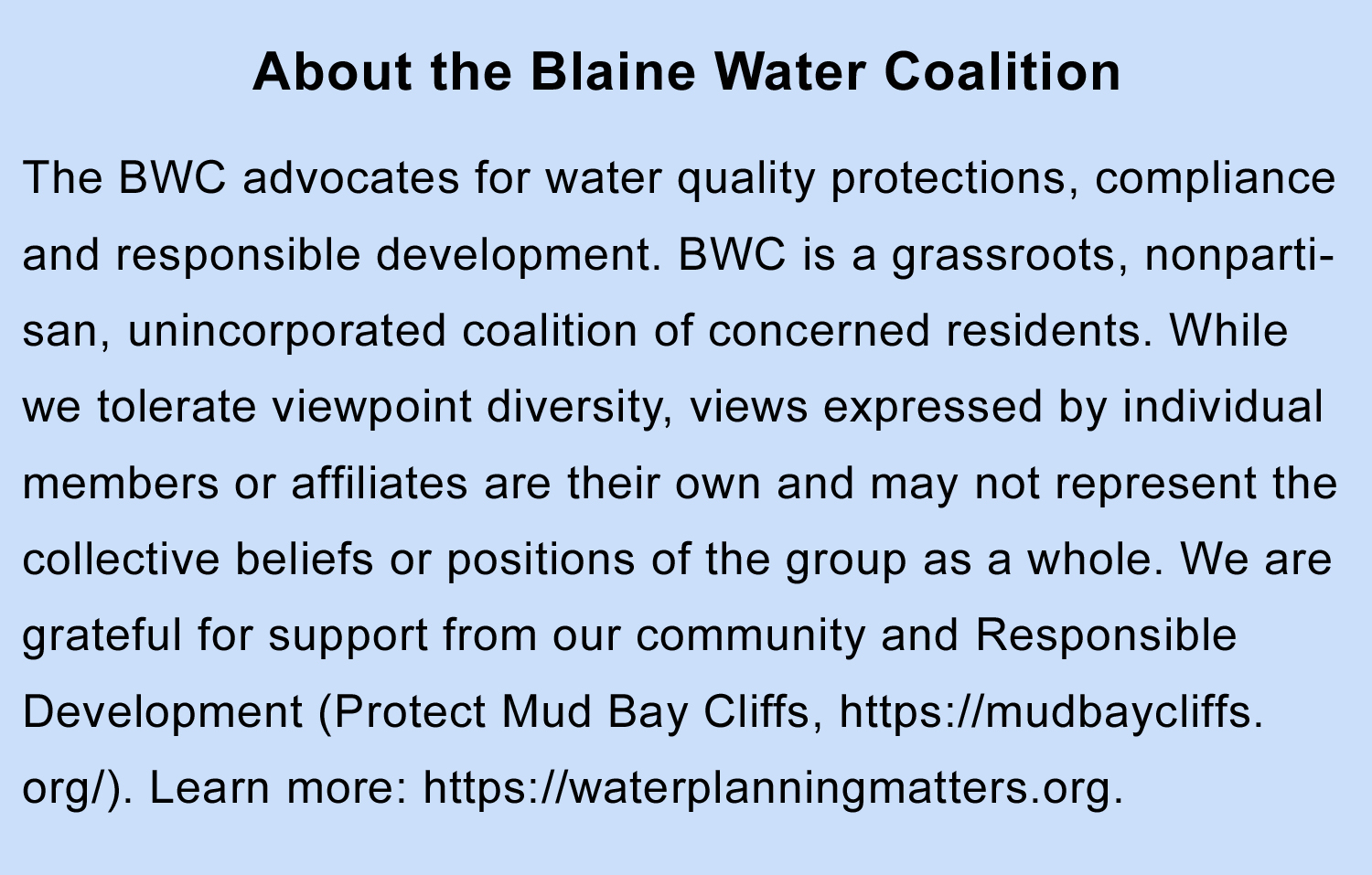
Investigation: Between 2022 and 2025, our community volunteers (BWC) prepared investigative reports and testimony in five quasi-judicial hearings for environmental SEPA determinations. Our group analyzed 1,000-plus municipal records and correspondence, attended over 40 council and planning meetings, provided over 100 comments and 20-plus report submissions to city, county, state and federal agencies, and met with over 30 state and federal officials for major land-use decisions in Blaine. We attempt to ground our investigative research in best practices for civil engineering, earth sciences, land-use laws and regulatory compliance.
Regulatory Capture & Deflect, Select, Obfuscate (DSO)

City council and planning decisions in Blaine reflect regulatory capture dynamics, where special group interests and lax state environmental compliance maximize tax revenues for city services and infrastructure growth at the expense of citizen interests and environmental quality. The following dynamics in Blaine weakened public trust in local government:
- Captured decision-making: (planning commission members stacked with realtors and developers), financial barriers (high appeal fees, go straight to court)
- Procedural barriers: (opaque quasi-judicial hearing examiner process, siloed state authority)
- Legal barriers: Vesting of completed developer applications based on outdated stormwater rules, or legal pathways enacted to stop citizen appeals, diluting conflict of interest provisions by city attorneys.
- Revolving doors: Whatcom ex-planning department consultant rewriting local zoning codes to favor client real estate sales without disclosing conflicts of interest to influence land-use decisions.
- Information asymmetry: Developers receive complete access to planning resources; public information access is redacted or obstructed for details on meetings, emails, teams’ chat notes, and regulatory permit notes.
- Regulatory shopping: Municipal code authority is used to override state rules with impunity — make it cheaper to develop by relaxing zoning requirements; increasing buildable footprints (lower wetland buffers, setbacks and averages); decrease compliance cost for environmental pollution standards (Blaine’s waiver of 2024 Western Washington Stormwater Plan in local code); and reduce developer liabilities — flipping of plats to individual homeowners to waive Shoreline Management Plan (SMP) compliance, NPDES Type II exemptions and waive stream setbacks).
- Selective compliance/nonenforcement: Environmental setbacks, SMP shoreline violations, Critical Aquifer Recharge Areas (CARAs), Growth Management Act (GMA), and groundwater charging areas are violated without local or DOE enforcement.
- Control, narrow viewpoint diversity, opaqueness: Use state party operatives to install candidates to ensure majority council control, extend term limits of planning commission members, and handpick members by the mayor, council members or city manager. Squash diversity of viewpoint by banning First Amendment free speech by citizens for over 18 months in city council meetings.
- Retaliate: Use city council chamber rules to discipline council members who dissent, hire PR firms and pay the press, retaliate against citizens who, under compliance and rule of law, are whistleblowers about pollution issues.
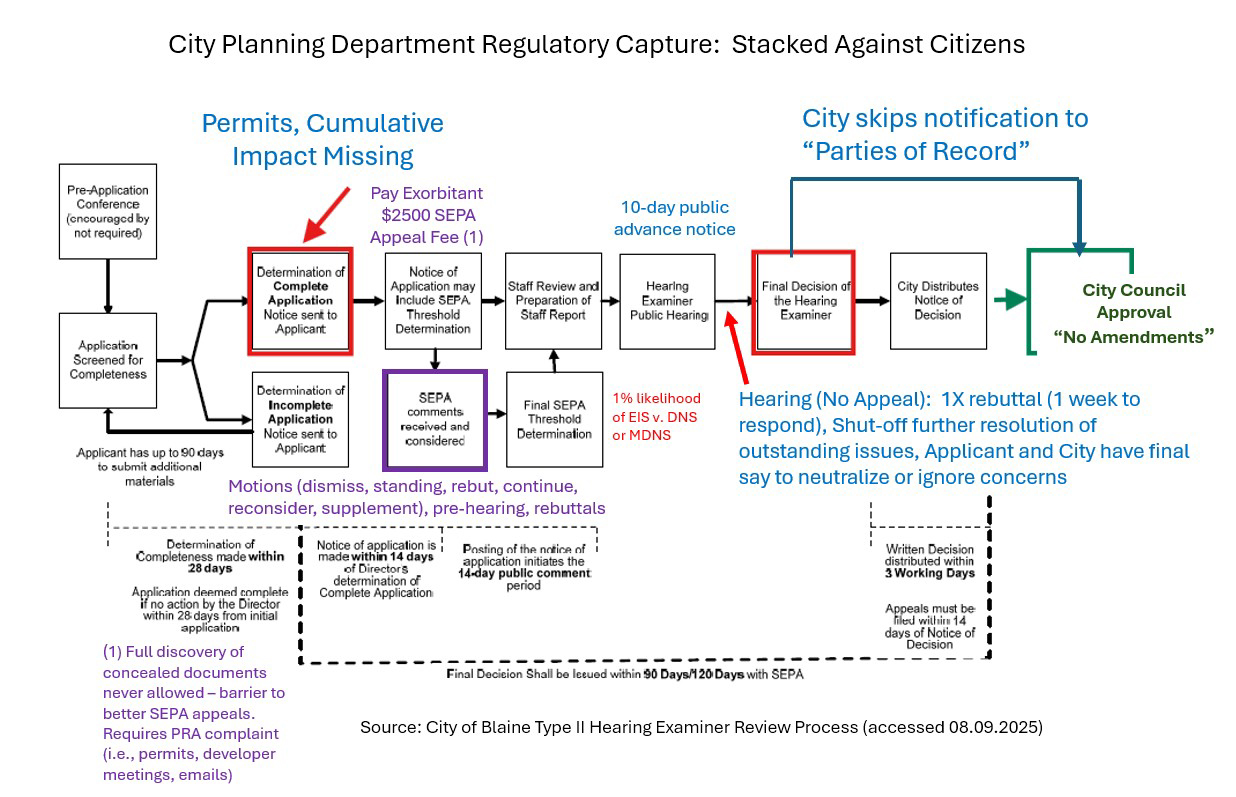
The Deflect, Select, Obfuscate (DSO) Rule Playbook:
Below are 10 ways we’ve observed how Blaine Planning uses “Regulatory Capture” to shape City Council land- and water-use decisions. This article focuses on the top four.
Rule 1 – Use a quasi-judicial hearing examiner process to marginalize environmental compliance. (Deflect)
Rule 2 – Deem premature PUD applications as “Complete” — when critical information is missing, outdated, omitted, insufficient or incomplete. (Select)
Rule 3 – “One plat at a time” to diminish SEPA scope and cumulative impacts for Environmental Impact Statement (EIS). (Obfuscate)
Rule 4 – Charge exorbitant SEPA appeals fees, undermining the statute’s promise of meaningful local review before court.
Rule 5 – Control the record and timing. Post key materials late, compress comment periods, withhold or “not adopt” agency comments, and schedule hearings to minimize public participation; keep the record thin and procedurally “complete.”
Rule 6 – Treat broader impacts as out of scope. Exclude regional, downstream, tribal, climate, and infrastructure effects as “not part of this action” — narrow local code findings.
Rule 7 – Rely on older standards and stale studies. Apply superseded stormwater/buffer manuals via vesting claims; lean on 10- to 20-year-old hydrology reports without supplementation.
Rule 8 – Proceed amid unresolved conflicts and concentrated control. Keep city-paid examiners, consolidate advisory roles, and proceed despite apparent conflicts of interest; frame objections as non-jurisdictional.
Rule 9 – Minimize interagency coordination. Avoid or delay USACE/Ecology/DOH/county coordination when it would trigger stronger protections; don’t adopt external analyses into the SEPA record.
Rule 10 – Exhaust opponents through procedure and cost. Use complex filing requirements, short deadlines, and stacked fee/cost exposures (records, transcripts, experts) to drain time and resources and deter appeals.
- Rule 1 (Deflect) – Use a quasi-judicial hearing examiner process to marginalize environmental compliance
Blaine Hearing Examiner (HE) Process
The HE is a “quasi-judicial” framework designed for citizens to comment on development projects and rezoning that impacts communities (i.e., open space, shorelines, wetland downgrades). About 71 percent of the towns and cities in Whatcom County use the HE process (134 cities in WA state, around 80 percent). (iii)
In our experience with five hearings to date (iv) — the HE process functions like a court: formal, criteria-bound, and record-based. It offers limited environmental protection and compliance with tight filing windows for arguments or broader community input. The HE’s job is to apply code criteria, not citizen opinions, giving more weight to special interests and developer-paid technical reports (wetlands, critical area, geohydrology, traffic, etc.). WA state is unique in this regard since it allows interested party report submission for examiner consideration with planning departments that fail basic audit controls for segregation of duty and duty of care.
However, the Hearing Examiner does consider county technical assessments if a city is impacting a neighboring jurisdiction, such as our case, where Blaine’s development impacts Birch Bay in Whatcom County. Still, in our recent Inverness Hearing [37-acre property, 63 single-lot homes], cumulative county traffic, untreated stormwater (use of 2019 instead of 2024 stormwater plan) and infrastructure cost-shifting concerns were dismissed, leading to rapid city council approval 10 days later.
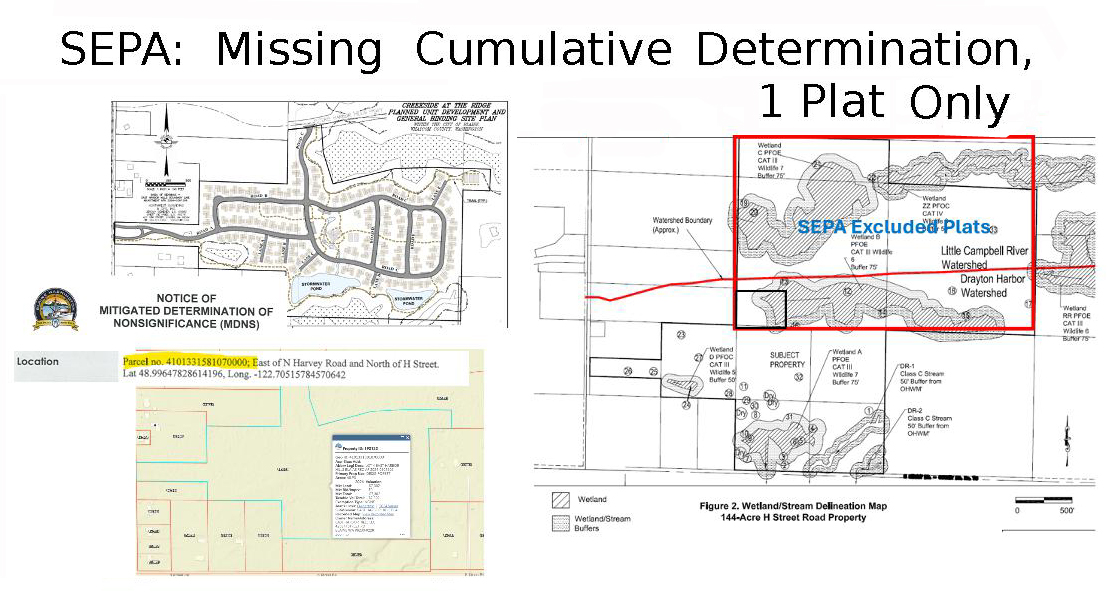
Blaine’s Bewildering Appeal Process
On May 20, 2024, the Blaine planning department [Community Development Services Department] stripped the Planning Commission (majority developers and realtors) of its ability to approve projects. The process was moved under the ultimate control of Blaine’s planning department. It’s intimidating and intensive for most citizens. Citizens cannot cross-examine questionable developer or hearing examiner assertions and further discovery is shut down after a round of rebuttal within a week. Then, within a month, the Blaine City Council holds “closed record” reviews; no new testimony is allowed, so later evidence or broader policy pleas cannot be added.
It doesn’t appear to be fair and feels more like the door closing on public input. Council member questions are few, if any, with debate scripted for public consumption and the framing of comments and issues controlled by the Blaine planning director.
- Rule 2 (Select) — Deem premature PUD applications as “Complete” when critical information is missing, outdated, omitted, insufficient or incomplete
Our experience with seven hearing processes (planning commission, Hearing Examiner and SEPA appeals) identified that the Blaine planning department consistently “issued premature project acceptances.” For example, when two developer applications neared expiration, the department declared them complete for council vote (Avista, Creekside) and then issued back-to-back SEPA determinations despite gaps in important details.
This tactic circumvents SEPA’s requirement to base a Determination of Nonsignificance/Mitigated Determination of Nonsignificance (DNS/MDNS) on adequate information so that specific, enforceable mitigation can occur. When details are missing or omitted and citizens have only 14 days to file a SEPA appeal, this tactic puts any investigator asking legitimate questions at a severe disadvantage. We identified several tactics used by the Blaine planning department:
- Failure to obtain, adopt, or consider material agency information from USACE, Department of Ecology, or the county before the SEPA determination (Avista, Creekside, Semiahmoo Spit), contrary to SEPA provisions, allowing adoption/supplementation and requiring an adequate basis for a DNS/MDNS.
- Leaving developer obligations for infrastructure and traffic mitigation unresolved at the threshold stage, weakening assurance that MDNS conditions will be specific and enforceable as SEPA expects.
- Applying pre-2024 stormwater/buffer standards without a valid vesting or transition basis, inconsistent with integrated project review/vesting principles under RCW 36.70B.
- Inadequate analysis of wetland-aquifer connections and WOTUS pathways, including reliance on outdated buffer averaging and misclassification of wetlands, which risks understating probable significant impacts under SEPA’s threshold rules.
- Reliance on 10- to 20-year-old hydrogeology that does not reflect changed rainfall, growth, or aquifer travel times, rather than supplementing to ensure the threshold decision reflects current conditions. (v)
- Insufficient water-quality monitoring/mitigation conditions for stormwater pond release (e.g., nitrogen, arsenic, hydrocarbons, temperature) in areas affecting drinking-water aquifers and shellfish waters, making an MDNS vulnerable because mitigation must be specific and enforceable.
- Rule 3 (Obfuscate) — “One plat at a time” to diminish SEPA scope and cumulative impacts for EIS.
In cases of two PUD applications, we found the SEPA review was scoped to the first preliminary plat or early permit while deferring later phases (e.g., contiguous Avista/Inverness, Creekside). This narrows the determination scope, the area subject to public scrutiny, to an initial slice and diminishes EIS consideration of cumulative impacts from the full buildout.
Segmenting interrelated projects (e.g., contiguous Inverness/Avista, Creekside) so cumulative impacts are minimized, contrary to SEPA’s directive to define the entire proposal and consider cumulative effects when deciding DNS vs. DS/EIS (WAC 197-11-060).
SEPA requires the lead agency (Blaine planning department) to define the entire proposal and to consider direct, indirect, and cumulative impacts when deciding DNS vs. DS/EIS. Phasing is allowed only if it proceeds from broad to narrow — evaluating the overall multiphase plan first, then adding detail as phases advance — and it cannot be used to avoid cumulative impact analysis or alternatives review.
Another tactic is segmenting interrelated projects that share knock-down effects, “cumulative effects,” such as stormwater drainage, traffic patterns, and groundwater. This is contrary to the cumulative effects when deciding DNS vs. DS/EIS (WAC 197-11-060). Currently, there appears to be no enforcement we are aware of by DOE of these requirements or by the Blaine Hearing Examiner.
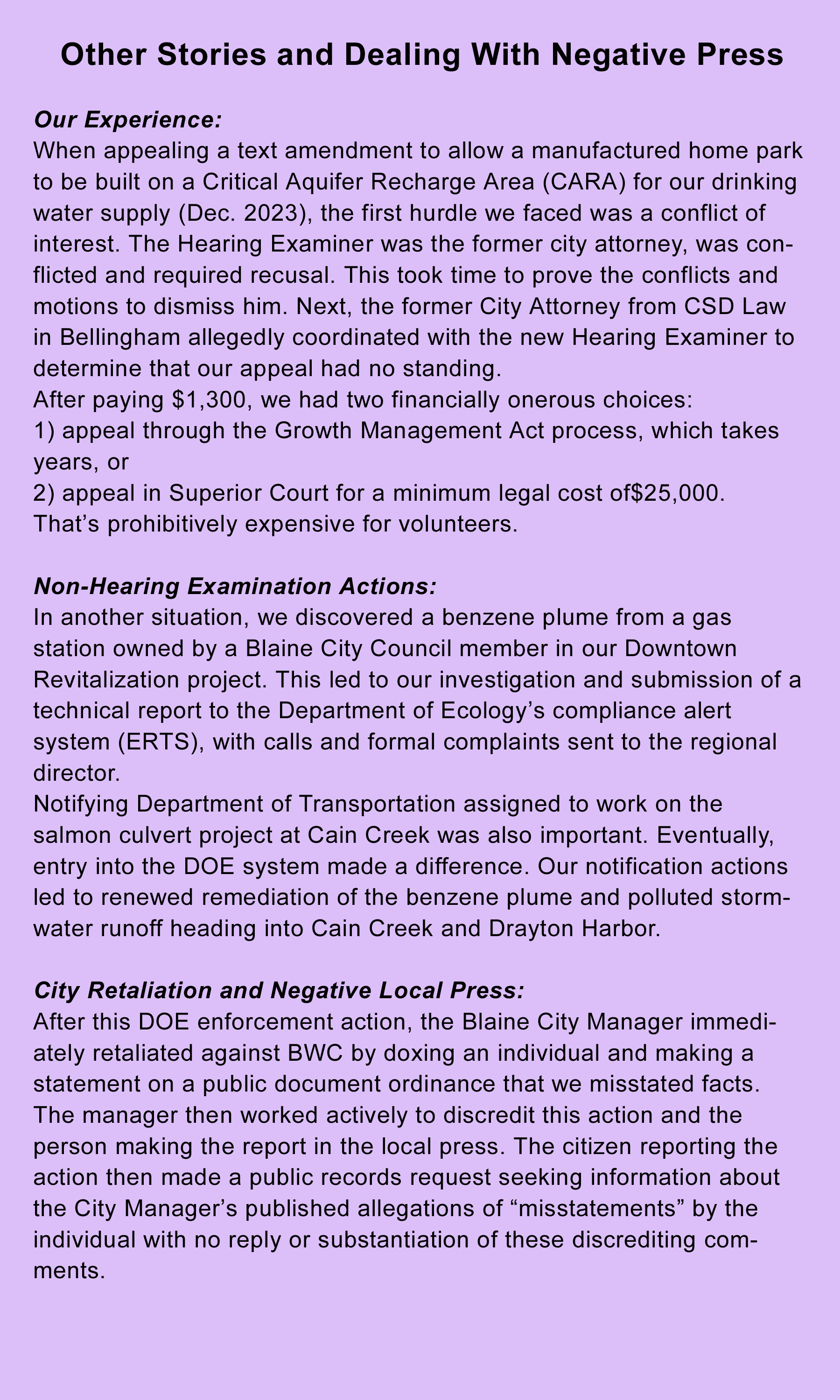
It’s Too Late
When later plats are treated as outside the original SEPA scope without an upfront, program-level look at the whole development, the effect is functional segmentation: public input is limited, foreseeable impacts (traffic, water demand, stormwater, wetlands, natural habitat) are understated, and the DNS/MDNS is inaccurate because it failed to contemplate and address combined impacts before the threshold decision.
Federal and State Agency Oversight During the HE Process
We observed that the Hearing Examiner may consider critical permit reports from U.S. Army Corps of Engineers, NOAA, or on rare occasions DOE comments (only if citizens are proactive). However, we found the Blaine planning department has consistently omitted agency permit feedback, particularly critical DOE assessments before a hearing, or worse, citizens were not allowed to engage with federal and state agencies on environmental compliance across air, water, and other laws.
In Blaine, the planning department has pursued “after-the-HE-and-City-Council-decision” permitting. Such permits are perfunctory with little consequence, compliance enforcement, or impact mitigation for the developer.
Why Citizens Become Frustrated
This hearing examination process is designed to tire you out. Few can take the time off, sacrifice family life or have the money to persist. The Blaine planning department banks on your burnout using regulatory capture to their advantage. This is why citizens find it very frustrating and disengage when they feel the examiner gives more weight to biased technical reports than their comments, including offering the last rebuttal (“say”) to the developer and City of Blaine.
Due Process, Information Asymmetry
Blaine’s planning department has years of experience using opaque, conflicting codes, backdoor provisions (ruling on stormwater plan) and selective excerpts from developer reports to confuse citizens or neutralize environmental concerns such as cumulative impact to influence the HE’s final report — and subsequent Blaine City Council rubber-stamp approval. There is no appeal process except for the court, even when the HE’s report may be wrong or case law is intentionally misapplied. The process is designed to expedite development projects under the patina of an “Appearance of Fairness” doctrine.
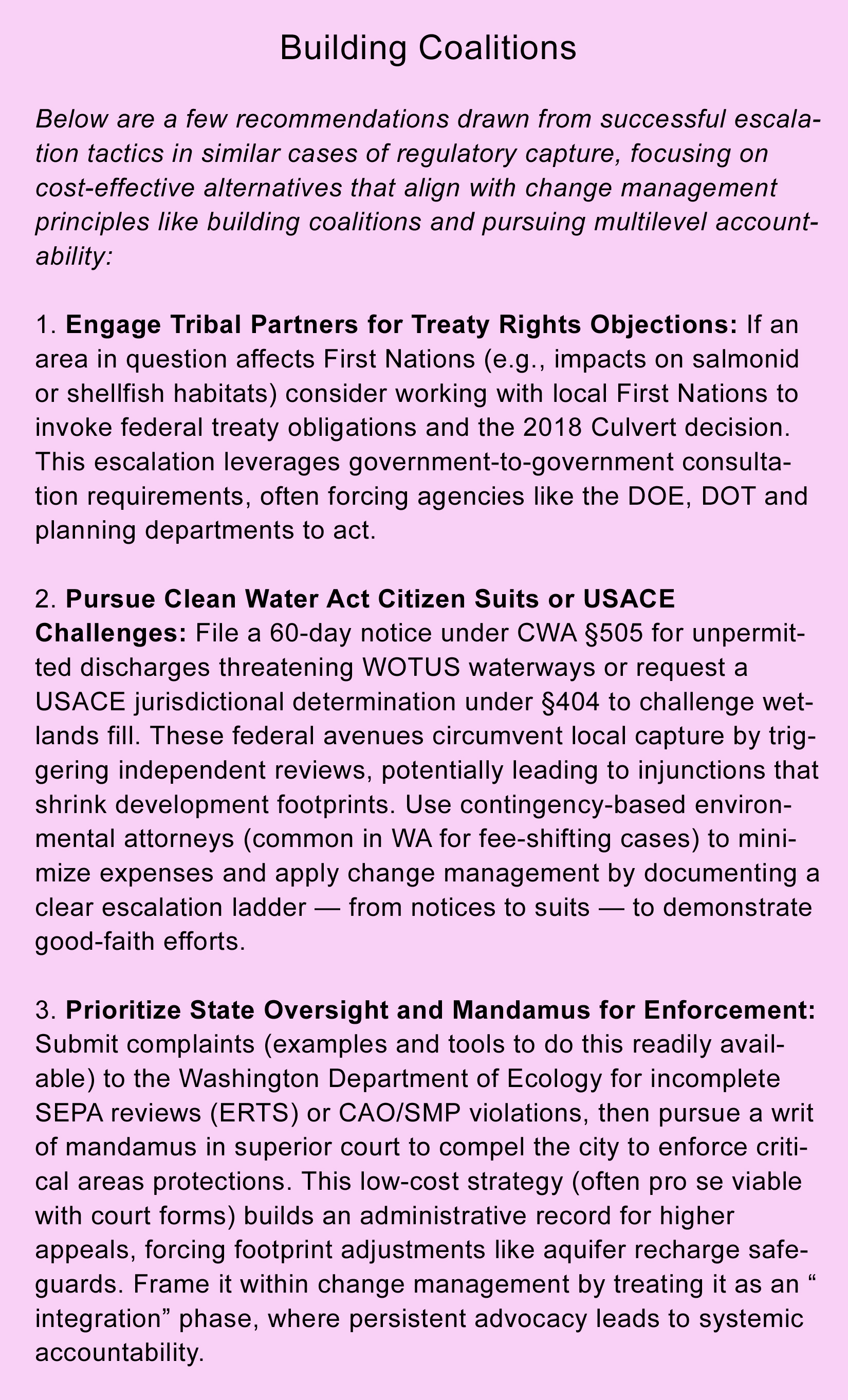
Lessons Learned — What Matters
We learned that volunteer citizens with even minimal science or technology experience can make a difference by:
- Identifying and proving misleading assumptions in developer reports,
- Conducting outreach with ositive impact, such as assistance from local organizations like Mud Bay Cliffs, Birch Bay community leaders, homeowner associations and selected Whatcom County executives,
- Pleading with the overstrained DOE (rarely does the DOE provide third-party, disinterested review),
- Ordering extensive public records’ information discovery requests immediately upon City of Blaine posting of SEPA notifications (i.e., developer meetings, Microsoft teams’ chat, emails, correspondence with regulatory agencies, versions and corrections made to SEPA checklist, developer application submissions, etc.).
- Rule 4: Charge Exorbitant SEPA Appeals Fees. The SEPA appeals process offers more rights to question, review and rebut technical reports from the planning department and developer applicants. However, in Blaine, the city has intentionally set fees exorbitantly high to discourage citizen participation. Our first appeal on a rezoning project that impacted salmon habitat and groundwater recharge was rejected when a deposit was made without full payment. This pay-to-play hurdle is one that few of us can meet. More recently, we started community fundraising, raising $2,500 to appeal Avista [Avista at Birch Point is a proposed 181-acre subdivision and planned unit development containing up to 490 residential units]. The chart above shows that our fees are about two-and-a-half-times Whatcom County’s and unprecedented. The City of Blaine has refused to provide any financial relief despite our demonstration of financial hardship.
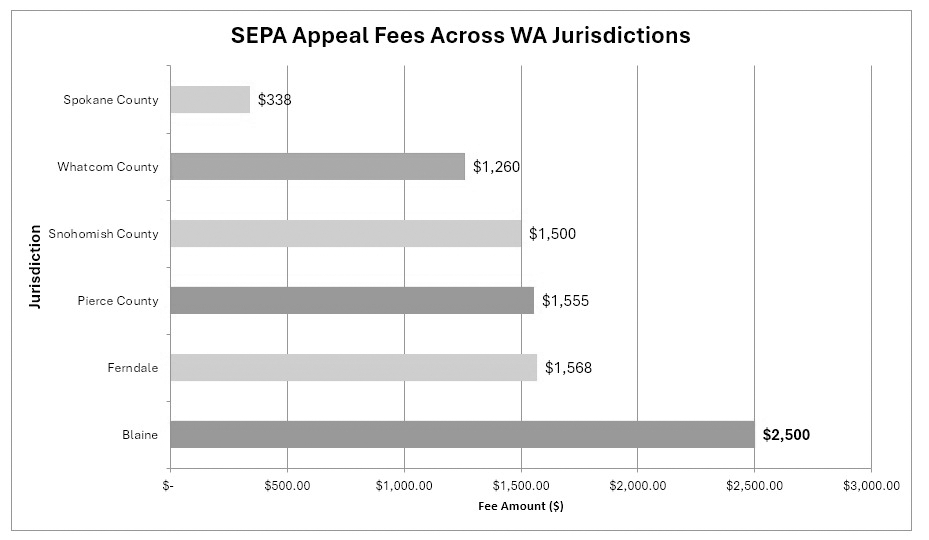
Fees deter appeals and exhaust resources. While this article goes to press, we are in early observation of our SEPA appeal process. We are focused on an EIS determination, but understand it’s a statistical long shot. On an MDNS appeal such as ours, hearing examiners and courts give “substantial weight” to the lead agency, including our conflicted Blaine planning department.
However, a determination can be overturned only if it is:
- erroneous (i.e., relies on outdated manuals and data or developer-paid technical studies that could be inaccurate)
- missing critical studies (e.g., groundwater/cumulative impacts absent)
- development project segmentation that masks probable significant cumulative impacts
Based on our early discovery, we believe conditions for a successful EIS appeal exist. We are outspent and outnumbered as the City of Blaine and developer expand their cadre of attorneys.
Lessons Learned — The Value of Early Public Records Act
(PRA) Discovery
PRA request discovery is important, particularly when the planning department holds back important information or the HE expresses hesitation in supporting citizen discovery. Early on, we filed a complaint with Whatcom County Superior Court and served the City of Blaine with full discovery. We take this exercise seriously, using e-discovery tools to rapidly vet and tag information for evidence that supports an early EIS determination, including supporting our posture for a State Court filing once the HE process concludes.
When requesting records, we’ve learned that it’s important to exercise on-site file inspection rights since documents may sit in the Public Works Department, the planning department, finance or other areas. The City of Blaine has resisted such efforts, but, from experience, we know there are unredacted records that the city overlooks or delays when responding to Washington Public Records Act requests. We also ask for an exemption log so the city records anything not in their possession for compliance in a court of law.
For example:
- Emails, notes and Microsoft Teams’ chat among city departments regarding the project and ancillary infrastructure costs,
- Versions of completed developer agreements,
- Cost-shifting of road improvements for traffic to neighboring jurisdictions.
Discovery of Blaine’s City Records addresses the information asymmetry problem mentioned earlier by:
- Finding hidden documents like DOE reports not posted on the Blaine’s website.
- Helping citizens prepare technical report rebuttals to erroneous assumptions that the City of Blaine or planning department typically fails to review, won’t review or doesn’t have the expertise to respond timely. Examples include:
- Who pays for the roads, water extensions, stormwater pond-maintenance and infrastructure— taxpayers, future HOA owners or developers?
- What important decisions and environmental concessions were made with developers in meetings?
- What detailed notes from developer meetings, regulatory agencies (DOE, USACE, etc.) and emails are missing?
- Who were the independent experts that reviewed the wetlands delineations, classifications, setbacks and property waterflows? What methodology and technology were used for such an assessment? What data points are available?
- What did the DOE have to say about the wetlands? Is there untreated/unfiltered stormwater fl owing to Waters of the United States (Birch Bay or Drayton Harbor via creeks)?
- How are groundwater recharge aquifers being impacted and how does this affect generative drinking water aquifers and wellhead pumping areas?
Change Management and the Art of Escalation
In the past two years, we’ve climbed a steep learning curve. We’ve applied e-discovery to gain a deeper understanding of the City of Blaine’s playbook for maximizing tax revenues and controlling a narrative that doesn’t always balance citizen needs for lower cost of living, reliable clean water and environmental quality.
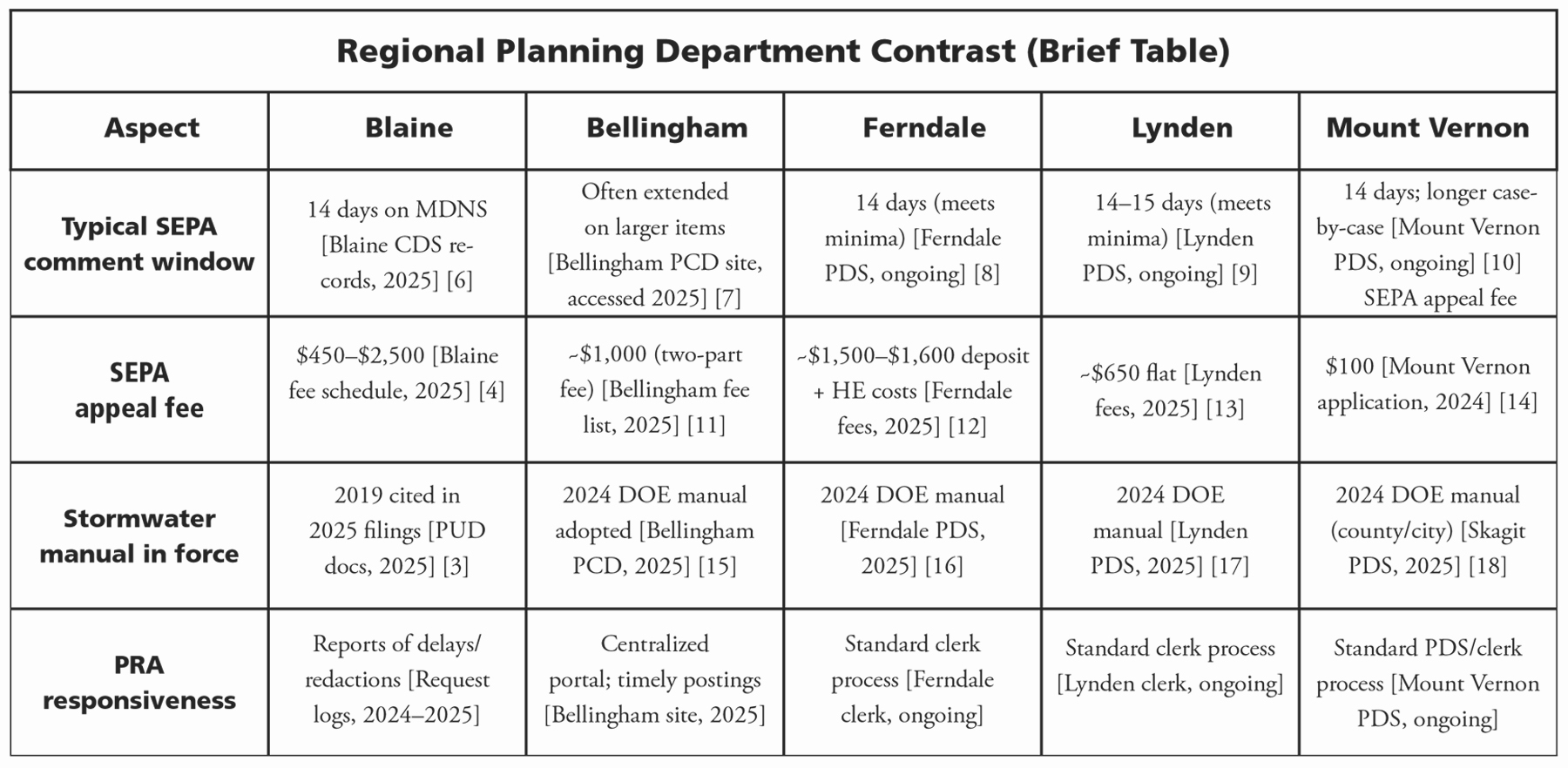
While Blaine planning department’s DSO (deflect, select, obfuscate) approach to working with citizens may not reflect your community, we believe it’s important to meet people where they are and apply change management principles; then exercise escalation ladders when municipal officials fail to listen or respond to community voices. We’ve strengthened our outreach to amplify our voice and push past the City of Blaine’s regulatory capture barriers and acts of retaliation.
________________________________-
Tina Erwin CDR USN (Ret.) spent 20 years in the Navy, working for the U.S. Submarine Force, as a terrorist expert, retiring at the Commander level. She also has a Master’s degree in management. Tina is currently the author of nine books on metaphysics.
Otto Pointer, Alias Protected by Anti-SLAPP Act, enjoys working at the intersections of technology, public health, compliance and sustainability. Having grown up overseas, Otto respects diverse viewpoints, staying non-political and overcoming challenges with persistence. He has graduate degrees in healthcare and economics. Otto believes we have great potential in Whatcom County to advance stewardship, quality of life, and economic opportunities for well-paying jobs. It starts with citizen say, oversight and transparency in local government practices through evidence-based reporting.
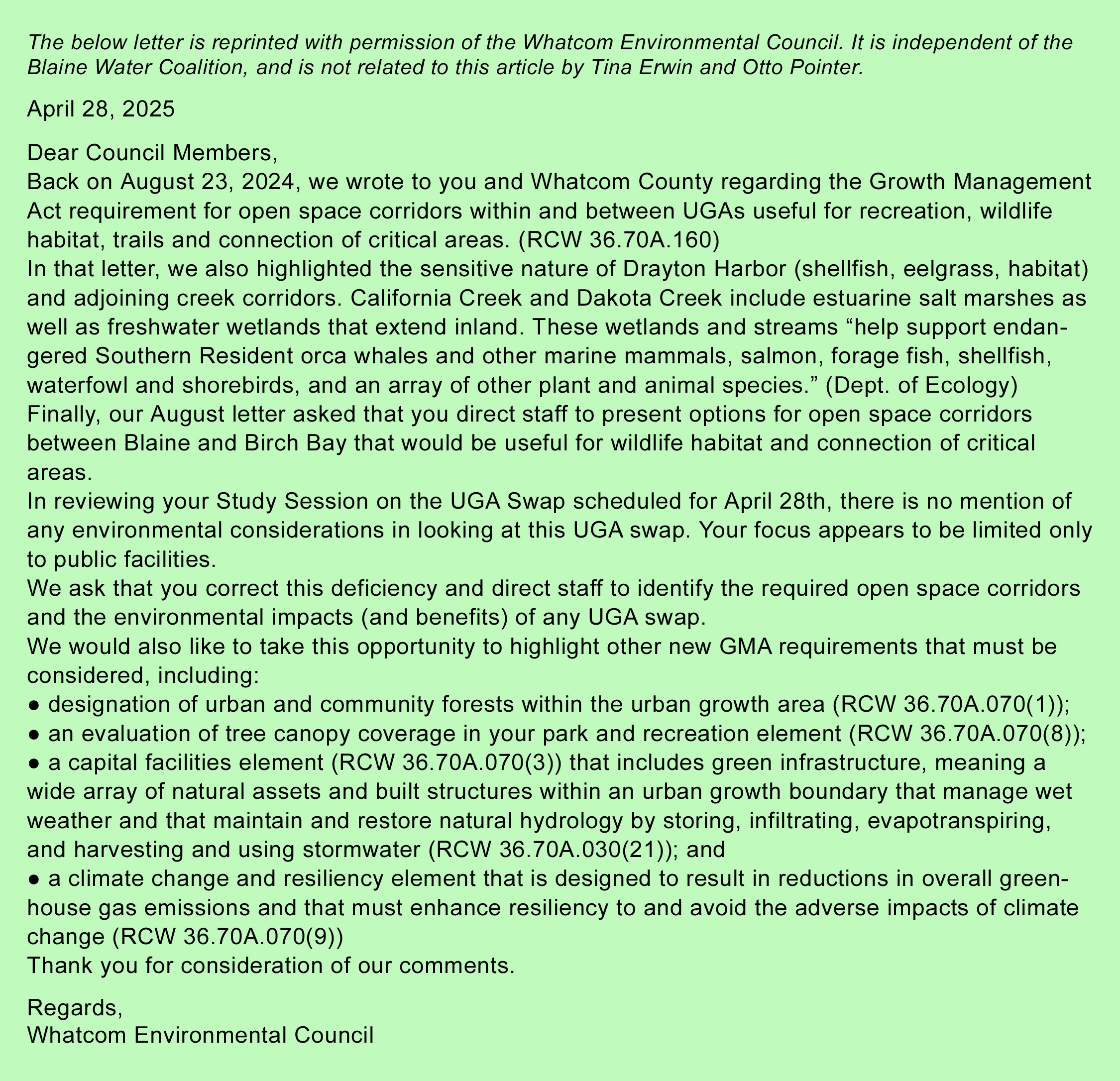
Endnotes:
(i) A pseudonym used to minimize retaliation risks
— a request for pseudonymous court filings has been submitted.
(ii) Source: CFA Institute. Regulatory Capture is a phenomenon where
a government agency, intended to safeguard the public interest,
instead begins to prioritize the agendas of powerful special interest groups
within the industries it oversees. Essentially, the very entities meant to be regulated
end up influencing the regulators, leading to decisions that benefit private commercial
or political concerns over the broader public good.
(iii) State of WA Fiscal Note Package 74376, p. 2 of 4.
(iv) HE Process Engagement by BWC: Mott’s Hill, Boat M Dock, Semiahmoo Spit,
Creekside, Inverness, Avista, Downtown Revitalization. Other planning processes:
Rezone UMC.
(v) Third-Party Aquifer Recharge Assessment (JIJ Corp, Creekside PUD,
February 27, 2024)
Research References:
- U.S. Census Bureau, Population estimates, July 1, 2024, (V2024). Pop. 6,371 https://www2.census.gov/programs-surveys/popest/datasets/2020-2024/cities/totals/sub-est2024_53.csv
- Office of Financial Management, Washington State. “Population by age, mapped by county.” January 3, 2025. https://ofm.wa.gov/washington-data-research/statewidedata/washington-trends/population-changes/population-age-mapped-county.
- Public Utility District documents, referenced for Blaine’s Stormwater Manual. PUD docs, 2025.
- City of Blaine. “2025 Unified Fee Schedule.” November 25, 2024.https://www.ci.blaine.wa.us/documentcenter/view/21474.
- Seattle Department of Construction & Inspections. “How to Appeal a Decision.” Accessed August 9, 2025. https://www.seattle.gov/sdci/resources/how-to-appeal-adecision.
- City of Blaine. “NOTICE OF NON-PROJECT SEPA THRESHOLD DETERMINATION.” 2025. https://www.ci.blaine.wa.us/DocumentCenter/View/22641/2025044-SEPA_-Ma-Zoning-Text-Amendment-MDNS.
- City of Bellingham. Planning and Community Development Department. Accessed August 9, 2025. https://www.bellinghamwa.gov/.
- City of Ferndale. Planning & Development Services. Accessed August 9, 2025. https://www.cityofferndale.org/.
- City of Lynden. Planning Department. Accessed August 9, 2025. https://www.lyndenwa.org/.
- City of Mount Vernon. Development Services. Accessed August 9, 2025. https://www.mountvernonwa.gov/.
- City & Ecology documentation (via PARIS) stating Bellingham appeal fee: “An appeal shall be accompanied by $1,081.00 fee. https://apps.ecology.wa.gov/paris/DownloadDocument.aspx?
- City of Ferndale. “Unified Fee Schedule.” February 28, 2025. https://www.cityofferndale.org/DocumentCenter/View/185.
- City of Lynden. “2025 Fee and Rate Schedule.” Accessed August 9, 2025. https://lyndenwa.org/DocumentCenter/View/2421/2025-Fee-and-Rate-Schedule-PDF.
- City of Mount Vernon. “NOTICE OF PUBLIC HEARINGS & DETERMINATION OF NON…”August 15, 2024. https://mountvernonwa.gov/DocumentCenter/View/16244/NPH-DNSissued
- City of Bellingham. Planning and Community Development. Accessed August 9, 2025. https://www.bellinghamwa.gov/.
- City of Ferndale. Planning & Development Services. Accessed August 9, 2025. https://www.cityofferndale.org/.
- City of Lynden. Planning Department. Accessed August 9, 2025. https://www.lyndenwa.org/.
- City of Mount Vernon. Development Services. Accessed August 9, 2025.https://www.mountvernonwa.gov/.

